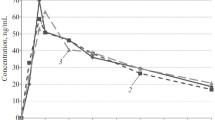Summary
The acute electrophysiologic effects of an intravenous bolus of ketanserin, a 5HT2 serotonin blocker, were studied in ten patients (four females, six males) during invasive electrophysiology. Following baseline electrophysiologic measurements during sinus rhythm and fixed-rate atrial pacing at 600 ms, a bolus of 0.2 mg/kg ketanserin was given over a 3-minute period. After 30 minutes all measurements were repeated. Systemic blood pressure was measured at regular intervals throughout. During sinus rhythm, there was no significant change in the basic cycle length or in the PA, AH, HV, QRS, QT, and QTc intervals. During atrial pacing there was a nonsignificant increase in the QT interval, from 342±13 ms to 366±16 ms, and a significant increase in the QTc interval, from 422±27 ms to 449±29 ms (p<0.05). There was no reduction in blood pressure. Thus ketanserin produced a significant prolongation of the QTc interval, in the absence of hypokalemia, in humans.
Similar content being viewed by others
References
Vanhoutte P, Amery A, Birkenhager W, Breckenridge A. Serotoninergic mechanisms in hypertension: Focus on the effects of ketanserin.Hypertension 1988;11:111–133.
Fozard JR. Mechanism of the hypotensive effect of ketanserin.J Cardiovasc Pharmacol 1982;4:829–838.
Breckenridge A. Ketanserin—a new antihypertensive agent.J Hypertens 1986;4(Suppl):S13–S16.
Reimann IW, Frolich JC. Is ketanserin a D receptor antagonist?Lancet 1983;1:703–704.
Saman S, Thandroyen F, Opie LH. Serotonin and the heart: Effects of ketanserin on myocardial function, heart rate and arrhythmias.J Cardiovasc Pharmacol 1985;7(Suppl 7):S70-S75.
Aldariz AE, Romero H, Baroni M, et al. QT prolongation and torsades de pointes: ventricular tachycardia produced by ketanserin.Pace 1986;9:836–841.
Bazan A, Aldariz AE, Baglivo H, et al. QT-prolongation by ketanserin and induction of malignant ventricular arrhythmias.Rev Argent Cardiol 1985;53:S88.
Zehender M, Meinhertz T, Hohnloser S, Geibel A. Incidence and clinical relevance of QT prolongation caused by the new selective serotonin antagonist ketanserin.Am J Cardiol 1989;63:826–832.
Lepeschkin E, Surawicz B. The measurement of the Q-T interval of the electrocardiogram.Circulation 1952;6:378–388.
Bazett HC. An analysis of the time relations of electrocardiograms.Heart 1920;7:353.
Zipes D. Proarrhythmic effects of antiarrhythmic drugs.Am J Cardiol 1987;59:26E-31E.
McKibbin JK, Pocock WA, Barlow JB, et al. Sotalol, hypokalemia, syncope and torsades de pointes.Br Heart J 1984;51:157–162.
Cameron HA, Waller PC, Ramsay LE. The effect of ketanserin on the QT interval (abstract).Br J Clin Pharmacol 1987;23:630P.
Nademanee K, Lockhart E, Pruitt C, Singh BN. Cardiac electrophysiological effects of intravenous ketanserin in humans.J Cardiovasc Pharmacol 1987;10(Suppl 3):S81–S85.
Drake-Holland AJ, Noble MIM, Pugh S, Mills C. Effect of intravenous ketanserin on the human action potential duration at fixed heart rate.Cardiovasc Drugs Ther 1988;2:239–243.
Author information
Authors and Affiliations
Rights and permissions
About this article
Cite this article
Kaye, G.C., Mehta, D., Wafa, S. et al. Acute electrophysiologic effects of an HT2-serotonin antagonist, ketanserin, in humans. Cardiovasc Drug Ther 4, 1157–1160 (1990). https://doi.org/10.1007/BF01856513
Issue Date:
DOI: https://doi.org/10.1007/BF01856513



